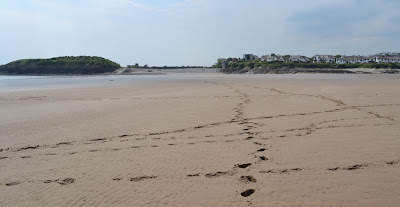We
parked at the beach and walked east up to the top of the cliffs, which were
low for 4km at the edge of arable fields.
Birds sang from every hedgerow and we noticed quite a lot of songbirds
– Blackbird, Chaffinch, Dunnock, Garden Warbler, and Stonechat – even a
Skylark singing on a fence post.
Botanically it was poor with one major exception – Corn Buttercup grew
at the edge of our path in just one field planted to wheat. The cliffs here are eroding and there are
frequent warnings and paths forced further back than they had once been. A particularly striking reminder was a
fence suspended in mid-air where the ground beneath had disappeared. At Summerhouse Point a former coastguard
station - Canolfan Seawatch Centre, which collects or collected data on
weather and coastal conditions, is now apparently closed "all day, every
day" according to the notice-board.
We came down to a small cove here, where we were forced to walk across
the boulders at the top of the beach, the (Un)Christian Centre occupying the
shore not allowing a path through their grounds. Due to the crumbling cliffs along this
section the beach-heads are strewn with boulders and extremely difficult to
walk. Then we were allowed back to the
field edges, but the path had been obliterated, and ploughed land with large
stones remained for us to plough through ourselves. After this field a coast path sign directed
inland along a hedgerow, but no room had been left by the rape crop and we
carried on along the former route at the edge of the field, at one time
having to circumvent a pile of cut scrub occupying the path. We were now approaching Aberthaw Power
Station, but the path, although rough, was now manageable just above the
boulder beach. After an area of
saltmarsh with English Scurvy-grass, that path ended at a car park beside the
power station, where a concrete walkway was provided all the way around the
edge between tall security fences on one side and a concrete embankment the
other. This was dull but at least easy
to walk, apart from it being appropriately named “dog shit alley”, as none of
the local dog-owners seem to have heard of removing their by-products, which
had accumulated all the way along. After
crossing the River Thaw we had an open grassy path above the beach through a
“biodiversity reserve” below a disused pumping station, with Pale Flax beside
the path and a large lake with reed islands and a scattering of water-birds
such as Heron, Pochard, and Tufted Duck.
Pale flax seems to be a common ingredient of these industrial
wasteland restoration sites, perhaps a constituent of some standard seed-mix
used by them. Above the
intriguingly-named Andrew's Pant saltmarsh was a bank of scrub below the
railway from
|
Purple gromwell
True service tree leaves
|
|
Corn buttercup
Difficult walking at Summerhouse Point
|
Cliff erosion
Pale flax
|
|
Aberthaw Power Station
Old Pumping Station and lagoon
St. Andrew's Pant saltmarsh
|
Soft mud,
|
Barry Docks













No comments:
Post a Comment